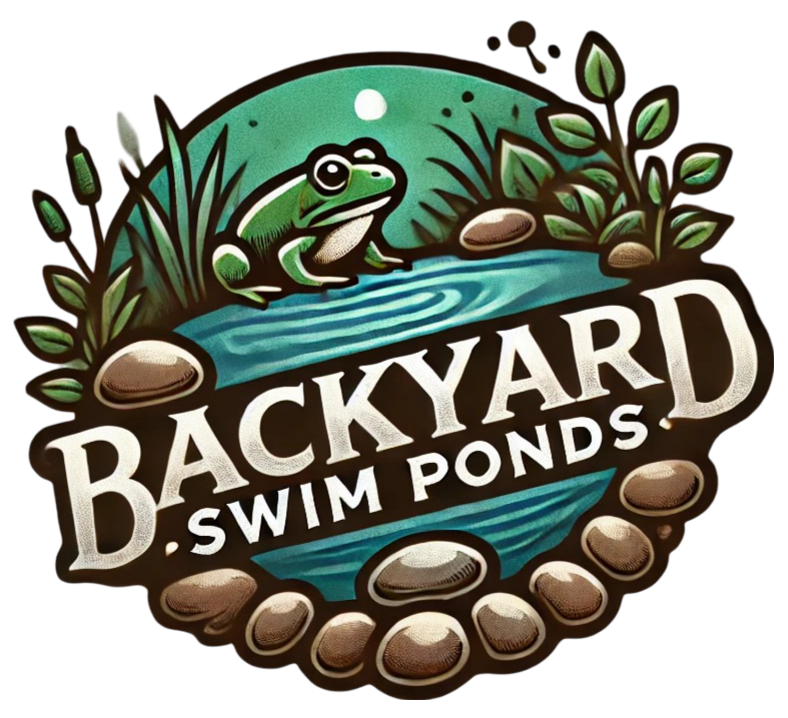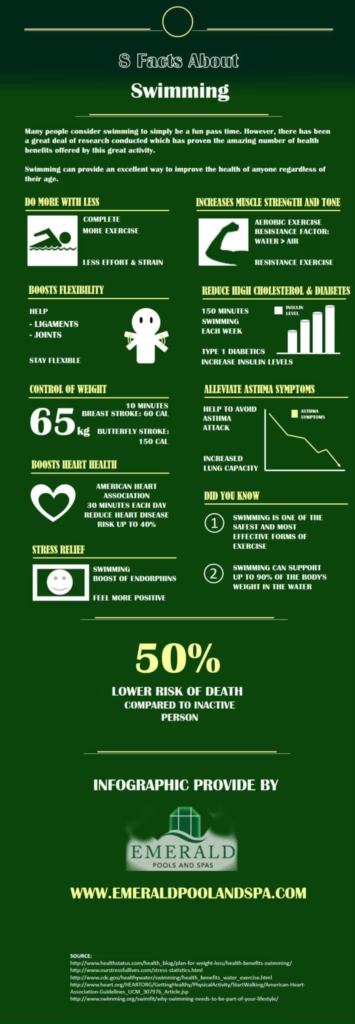Creating a biodiverse swim pond can be a rewarding addition to your home, merging ecological benefits with recreational enjoyment. A swim pond not only provides a refreshing place to cool off during warmer months but also supports a diverse range of wildlife. By establishing a pond that maintains both water quality and natural habitats, you enhance biodiversity, contributing positively to the environment while enriching your backyard experience.
In this guide, you’ll discover practical strategies and insights into creating a swim pond that balances aesthetic pleasure with ecological responsibility. You will learn about selecting the right native plants, implementing effective filtration systems, and maintaining a healthy ecosystem. Each component plays a crucial role in fostering a thriving habitat for aquatic life while offering you a beautiful space to relax and enjoy nature.
As you read through the sections, consider how you can incorporate these elements into your own backyard. The aim here is to create a space that not only meets your needs as a homeowner but also supports a broader ecosystem. Let’s dive in!
Why Create a Biodiverse Swim Pond for a Thriving Ecosystem?
Swim ponds are unique spaces that combine recreation and ecology, providing a sustainable alternative to traditional swimming pools. Rather than relying on chemical treatments, swim ponds function through natural biological processes, making them an appealing option for homeowners who prioritize eco-friendly living.
These ponds serve as habitats for a variety of species, contributing to local biodiversity. By integrating native plants, you can attract wildlife such as birds, amphibians, and beneficial insects. A swim pond also enhances environmental health by naturally maintaining water quality, which is essential for the plants and animals dependent on this habitat.
You’ll also find that creating a swim pond can significantly increase your property’s aesthetic appeal and value. Imagine stepping into your backyard oasis, surrounded by nature’s sights and sounds. This experience connects you to the environment in a meaningful way.
In summary, benefits of swim ponds include reducing reliance on harmful chemicals, promoting local biodiversity, and providing a natural recreational space for you and your family.
An infographic showcasing the benefits of biodiverse swim ponds including various examples of wildlife supported (Source: Emerald Pool and Spa).
Attracting Wildlife to Your Swim Pond: Tips and Tricks
Attracting wildlife to your swim pond involves thoughtful planning and design. The first step is choosing native plants that thrive in your local climate. Native plants provide food, shelter, and breeding grounds for various species. For example, incorporating Pickerelweed or Fragrant Water Lily can create essential habitats for frogs and insects.
Creating diverse microhabitats is crucial for attracting different types of wildlife. Ensure your pond features shallow areas and varying depths to accommodate wading birds and amphibians. Gently sloping edges also provide easy access for animals seeking water.
Additionally, consider adding features like log piles, stones, and native vegetation around the pond. These elements offer shelter for critters and basking spots for lizards and beneficial insects. If you ensure that at least 60-70% of your pond area is covered with native plants, you will foster a vibrant ecosystem that promotes biodiversity.

A vibrant image displaying a variety of native aquatic plants that create microhabitats in swim ponds (Source: Premier Pond).
The Best Plants for Enhancing Pond Biodiversity
When selecting plants for your swim pond, focus on native aquatic species that flourish in your specific temperate zone. For instance, in the Northeast, consider planting Fragrant Water Lily and Broad-leaved Pondweed, which provide crucial habitats and are known for their ability to filter water naturally. In the Midwest, Sweet Flag and Soft Rush enhance biodiversity while being low-maintenance.
Submerged plants, like Hornwort, oxygenate the water, while floating plants, such as water lilies, provide shade and habitat for aquatic organisms. Emergent plants, including Yellow Flag Iris, stabilize banks and offer shelter to various wildlife.
Aim to mix submerged, floating, and emergent plants to ensure a diverse ecosystem that attracts multiple species. Studies show that having a minimum of 60% plant coverage improves the overall health of your pond and enhances its capabilities to filter water and support wildlife.

A visual chart featuring suggested native plants ideal for pond biodiversity (Source: Natural Habitat Museum).
Maintaining a Balanced Ecosystem: Swimming and Nature
Finding a balance between the recreational aspect of your swim pond and its ecological role is vital for long-term sustainability. Natural filtration systems are an essential component in maintaining water quality while providing a clean swimming environment. Systems like the Aquascape Wetland System utilize plants and gravel beds to filter water naturally while also providing habitat for wildlife.
Regular maintenance is crucial to keeping your pond thriving. Avoid chemical treatments that can harm aquatic life; instead, focus on organic solutions and biological filtration methods to manage algae and maintain clarity. Adopting seasonal management practices also contributes to a healthy ecosystem; for example, allowing some leaf litter to settle in autumn can provide habitats for beneficial insects.
Implementing a monitoring system to regularly check water quality parameters—such as pH, ammonia levels, and nutrient concentrations—ensures that your pond remains a safe environment for both you and the wildlife that depend on it.
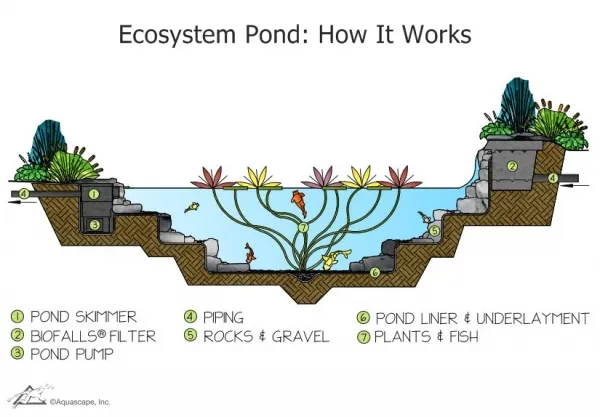
An illustration depicting the components of a balanced ecosystem in natural swimming ponds (Source: Aquascape Inc.).
Mosquito Management in Natural Swim Ponds
One common concern for swim pond owners is managing mosquito populations without using harsh chemicals. Mosquito management begins with understanding their breeding cycles. Most mosquitoes thrive in standing water, so creating a pond with moving water or adding features like fountains can discourage reproduction.
Utilize native plants that act as natural deterrents. For example, Sweet Flag not only adds beauty to your pond but also has properties that repel mosquitoes. Keeping your swim pond clear of debris and maintaining good water quality will also help prevent unwanted mosquito populations.
Regular maintenance and biological controls, such as introducing mosquito fish, can help manage mosquito populations while benefiting the pond’s ecosystem. With these strategies, you can enjoy a swim pond that is a delightful oasis rather than a breeding ground for pests.
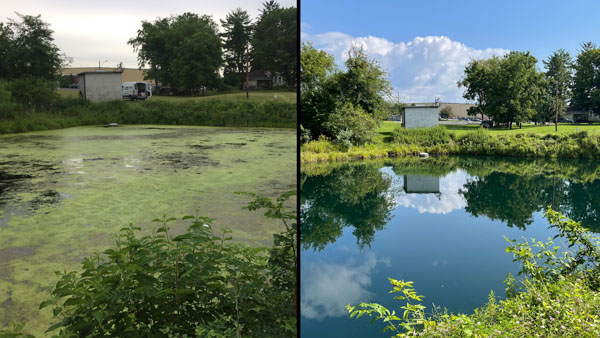
A before-and-after visualization of effective mosquito management in pond environments (Source: XJIRTP TVYI).
Natural Alternatives for a Healthier Pond Ecosystem
Opting for natural alternatives in pond care is essential for creating a healthier ecosystem. Avoiding chemicals not only protects aquatic life within your pond but also ensures safety for swimmers. Solutions like beneficial bacteria can effectively break down organic matter, keeping your water clear and healthy.
Consider investing in systems like the BioPool, which uses low-salt hydrolysis to maintain clean water without harmful additives. This innovative approach results in lower chlorine levels than standard pools and promotes a more wildlife-friendly environment.
Regularly testing your pond’s water quality, focusing on key parameters such as pH and nutrient levels, will help determine which natural treatments may be most effective. By opting for organic solutions, you contribute to a thriving habitat while enjoying a safe swimming experience.
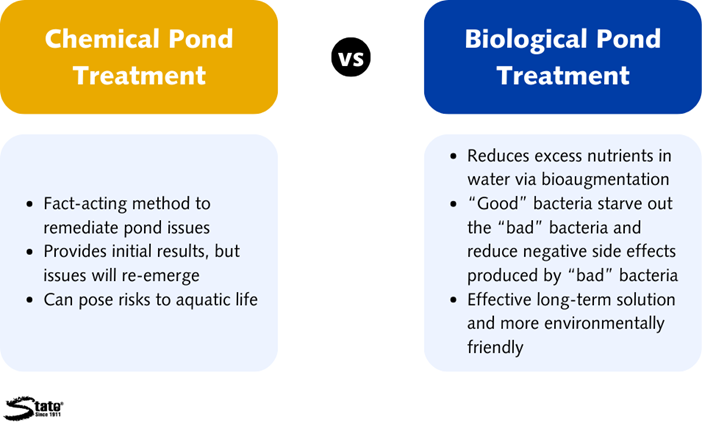
An infographic contrasting traditional chemical treatments with natural alternatives for pond care (Source: State Industrial).
Regulatory Considerations for Your Swim Pond
Before beginning the construction of your swim pond, it’s crucial to understand the regulatory requirements in your area. Different regions have guidelines that affect how you should build and maintain your pond. For instance, in the U.S., the Environmental Protection Agency (EPA) sets standards for water quality, including limits on bacteria levels and chemical concentrations.
Design features such as entry points, depth markers, and safety equipment must comply with local codes. Adhering to these regulations can help prevent future conflicts and ensure a safe environment for all users.
Additionally, it’s essential to consult with local authorities to identify specific construction permits required for swim ponds, as regulations can vary widely between states and countries. Proper planning will help you create a compliant, safe, and enjoyable pond.

A flowchart of regulatory processes related to swimming pool installations, useful for understanding compliance (Source: EPA).
Conclusion: Taking the Leap to Create Your Biodiverse Swim Pond
Creating a biodiverse swim pond is not just about having a recreational space; it’s an investment in the future health of your local ecosystem. By following the guidelines presented in this guide, you can cultivate a natural habitat that supports an array of wildlife, enhances your outdoor experience, and minimizes ecological impact.
As you embark on this journey, remember that the choices you make—from selecting plants to maintenance practices—will significantly influence the health and vibrancy of your pond. Engage with local environmental groups or resources that can provide ongoing support and education.
Your commitment to fostering a biodiverse swim pond not only contributes to ecological sustainability, but it also creates a unique, expansive space for you to connect with nature. Now it’s time to take action and enjoy the fruits of your labor, knowing that you’re making a positive difference for both yourself and the world around you.
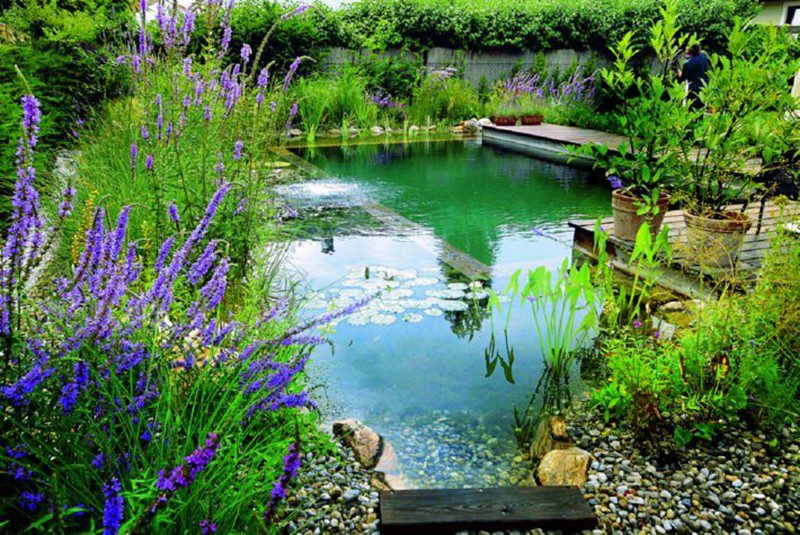
A scenic photo showing a beautifully flourishing swim pond with wildlife present, inspiring homeowners to take action (Source: The Owner Builder Network).
